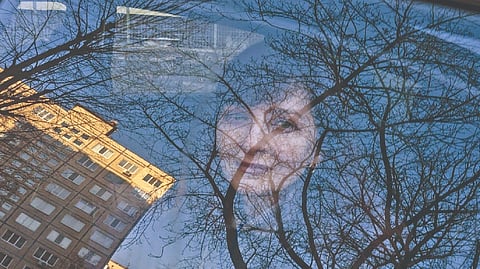

WASHINGTON: When the Russian invasion of Ukraine started, refugees began to stream away from the conflict and into neighboring countries. Mila Teshaieva, a Ukrainian artist who lives in Berlin, found herself traveling against the tide, driven toward her home country by what she called an “irrational impulse.”
“I wanted to live this moment,” she said. “I wanted to see it with my eyes. It was really important that I be present.”
On March 1, she arrived in Kyiv, her hometown. She walked alone through its desolated main street, Khreschatyk. Later that night, she sat down in the darkness of a smoking room at the hotel, and composed her first diary entry on her laptop.
“It’s cold outside and normally I would soon sneak into one of cozy restaurants around and call some friends to join me for a glass of wine. But today nothing is normal here,” she wrote. “Something unthinkable is going on, something that my mind refuses to accept. The WAR is here, in my country, in my city.”
For centuries, people have written diaries in times of war to document the crisis as it unfolded. In part, they did this in an effort to shape a narrative of the war: Teshaieva would later publish her diary entries and photos in the German online magazine Dekoder.org, which translates and contextualizes Russian and Belarusian independent media for the German public.
But for many, keeping a diary was also a way to cope with the fear and uncertainty of war — a retreat from a world gone mad.
In April and May, Teshaieva traveled to Bucha and Borodyanka, and other cities in the region that had recently been attacked and occupied by Russian forces. There, she encountered others who saw writing as a lifeline.
“I met a number of people who were sitting under shelling in this complete hell, getting crazy with all of it, and they were also writing diaries,” she said. “The women were telling me that they were writing by hand at night with no electricity, by candlelight, just to not go insane.”
The drive to keep a diary in moments of tension is not new. Rudolf Dekker, a Dutch historian, spent three decades creating an inventory of diaries collected in the Netherlands since the 15th century and found that there were spikes in journaling during times of war and political conflicts. “You see that people are aware that something exceptional is happening, and they want to record it for future historians, or for their children,” he said.
The French literary critic Philippe Lejeune observed that people tend to keep diaries in one of two circumstances: in adolescence, or when they are experiencing “moments of crisis,” whether personal or social. Anne Frank’s “The Diary of a Young Girl” is probably the best-known example of both. But beyond Frank’s account, there are tens of thousands of World War II diaries remaining in archives, said Dekker. “Everybody knows the history of the Second World War could not be written without diaries,” he added, “because so much other material was destroyed by the perpetrators.”
Visit news.dtnext.in to explore our interactive epaper!
Download the DT Next app for more exciting features!
Click here for iOS
Click here for Android